Steven
Lewis won our " Economy
River Cruiser" design contest a few
years ago. In the mean time he has been busy
designing all kinds of small, utility boats
for amateur construction and posting them on
his website.
This design he designated as a Duckworks exclusive
- it is a free download
that is available nowhere else. Thanks Steven! |
Duckskiff is a 14 foot skiff I designed
for a buddy of mine named Tim that I work with. Tim
is an avid Duck hunter and wanted a fairly lightweight
boat but in nice quiet wood rather than noisy aluminum.
He also wanted something a little boatier than a Johnboat
styled craft. What I came up with for him is a 14
ft long 5 ft wide at the shear (45 inches wide at
the bottom) kind of semi-dory hull. I did this to
make it an easier and dryer proposition when pulling
a large dog over the side and back into the boat.
The additional ultimate stability of the 23° flare
to the sides allows a lot of weight to be right at
the sides of the boat while at the same time getting
the shear lower to the water. He wanted to be able
to use his 7 hp motor to get around now with the probability
of upgrading to a higher hp later on. As the hull
was originally derived from a rowing style hull I
was playing with a few months previously I tweaked
both of them so that they were brother and sister
similar and decided to present them to you here. Enjoy…
Specifications for Motorized
version:
LOA |
- |
14’ 3” |
Beam |
- |
5’ 2” (with trim) |
Depth at midships |
- |
18” |
Draft at design weight of
860 lbs |
- |
4.5” |
Approximate boat weight |
- |
180-220 lbs |
Motor |
- |
to 25hp |
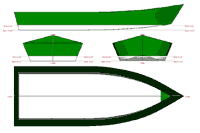 |
Motorized Version |
Specifications for Rowing
version:
| LOA |
- |
14’ 1” |
Beam |
- |
5’ 2” |
Depth at midships |
- |
18” |
Draft at design weight of
600 lbs |
- |
4” |
Approximate boat weight |
- |
130-160 lbs |
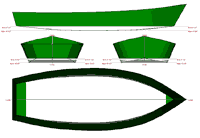 |
Rowing Version |
Introduction:
Using these instructions, along with the accompanying
sketches, drawings, illustrations, photos and tables,
you should be able to build either version of DuckSkiff14with
relative ease over the course of 2-6 weekends. The
original instructions were written for just the motorized
version but have been added to, amended to and revised
in the appropriate areas where the information or
building instructions differ for the rowing version.
Please take the time to read ALL of the information
as better than 90% applies to both forms of the boat
and in both methods of construction. The photos are
not of this particular boat but are used to illustrate
what a certain method or outcome should look like.
Do not be thrown off by a Vee bottom or a differently
shaped hull but use it as a visualization of one possible
way of doing something. The Photos are also not all
mine but are courtesy of my many online friends in
the various forums and groups that I inhabit
Steven's
plans consist of 61 pages of diagrams, detailed
instructions, offsets, and even photographs.
The plans are free to download
and you can build as many as you wish. |
Bill of Materials:
1: Two sheets of 3/8” (Row) or 1/2”(Motor)
plywood or MDO (Medium Density Overlay) for the bottom
(Note: the longest life can be expected from marine
grade plywood and MDO…lesser grades can be expected
to have a shorter life span)
2: Two sheets of 1/4” (Row) or 3/8" (Row
or Motor) plywood or MDO for the sides
 |
Panel layout
for Motorized version. |
3: One sheet of 1/4" plywood for seat boxes
(if building them)
4: One sheet of 3/4” plywood or MDO for transom
and doubler and also knees and breasthook if not using
solid wood (required only on the motorized version).
You can use 3/8” ply for the transom on the
rowing version provided you add some framing t o stiffen
it up a bit. The knees and breasthook can be of 1x
stock.
5: 12’ and 16’ lengths of 1x stock.
The amount will depend on the intended building method
and finishing. At a minimum you will need 2”-
3” wide strips for the inner and outer wales,
floor stringers, bottom rub strips and cleats…
plus additional 1 1/4” wide strips for Chine
Logs if building that way. You may also wish to use
1x stock for seat planks. If you choose to space the
gunnel you will need to factor that in too. Sit down
and calculate what you need by how you are planning
on building the boat. You should only need the 16’
stock for the gunnels, but you can get away with shorter
stuff if you don’t mind joints. All joints should
be in the aft sections of the boat. The better the
quality of the wood the easier to finish and the longer
lasting.
The Duckskiff
plans have 18 detailed illustrations like this
one to guide the builder through the construction
process:
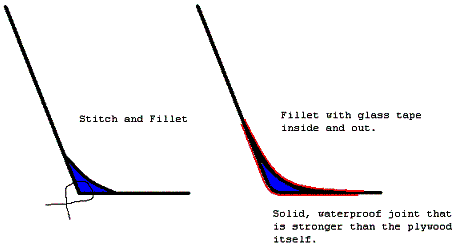
|
The plans
6: Stem piece: 28” long piece of 2”x3”
or 2”x4” fir or hardwood
7: A bag of 100 4” plastic wire ties or a
roll of copper wire for the Stitch and Glue version
8: Epoxy…the minimum amount of epoxy needed
is about 1 quart, for taping, gluing and filling on
a boat built with Chine Logs. Stitch and glue will
require another quart, as will glassing the bottom.
If you wish to totally seal the boat (not a bad idea
at all)…you will probably need all of the above
and an additional quart…so about 1 gallon of
epoxy. I don’t recommend polyester resin as
it is not useful as a glue, isn’t really waterproof
in the amounts you would use and doesn’t stick
to wood nearly as well as epoxy does. To save some
on epoxy you can use a glue like PL Premium polyurethane
glue when gluing parts together, but it tends to foam
up so it doesn’t work so well as a sealer.
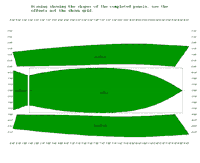 |
Panel layout
for Rowing version |
7: Filler for the epoxy…I like wood flour
mixed with Cabosil (fumed silica…wear a dust
mask) 2 lbs of wood flour and ½ lb of Cabosil
will do the trick for Stitch and Glue, half that for
Chine Log.
8: Fiberglass: Tape =10 yards for Chine Log, 25
yards for Stitch and Glue Cloth= 50” width x
5 yards 4-6 oz cloth if you plan on glassing it the
bottom.
9: Mixers, mixing containers, tongue depressors
or shaped applicators (for fillets) latex or plastic
gloves, dust masks, sandpaper, 3/4" Stainless
screws (if leaving them in) or drywall screws (if
removing) Clamps (cheap plastic ones are fine, or
cut some 4”-6”schedule 40 PVC pipe into
1” slices and split one edge for a really cheap
clamp), primer and paint. Deck and porch paint or
any good exterior heavy duty paint is fine along with
a good primer, Painters plastic or plastic sheet for
covering windows (better).
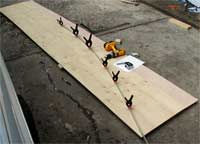 |
There are 18
photographs in the downloadable PDF plans so
there can be no confusion about the instructions |
10: Tools: The absolute minimum I would want to
get by with is a circular saw and a power drill/driver
for power tools although if you are good, a jigsaw
will do the job. Hand tools include a tape measure,
a square, a small block plane, a small hand saw for
trim work and a screwdriver. An Orbital sander is
a definite nice thing to have when it comes to rounding
the Chines over and feathering the tape edges in.
A table saw makes cutting bevels on long pieces a
snap too, so you might want to borrow or rent one
for a couple of hours and get all your parts cut out
ahead of time. If you don’t want to use screws
to hold things together…you will need a bunch
of clamps. Cheap spring clamps work most of the time
but you could probably use a few C (or G) clamps for
any tough stuff. You can also make cheap clamps out
of 6” Schedule 40 PVC pipe…just cut 1”-2”
slices of the pipe and then cut a slit in them so
you can open them up.
11: Batten: Personally I use a 1” x 1/8”
x 8’ strip of aluminum as a batten and I recommend
you do too, especially if you are building the Chine
log version. You can use a wider batten on the Stitch
and Glue version but you only have 1/2" space
for your batten and nails on each side when laying
out the bottom panel with the Chine log version.
Following is the outline of the building
instructions:
- Step One Laying out the panels:
- Option One: Stitch and Glue Construction for
both versions:
- Option Two: Chine Log Construction.
- Step Two: The Stem Piece:
- Step Three: Assembly:
- Joining the panels for either version or method
of construction:
- Assembling the hull (both versions) Stitch
and glue method:
- Assembling the Hull Chine Log Method:
- Bracing pieces:
- Seating:
- Finishing the interior:
- Finishing the outside-Stitch and Glue method:
- Finishing the outside-Chine Log method:
- Painting:
- Powering:
List of Pictures and Illustrations:
• Panel shapes (Motor)
• Panel shapes (row)
• Frame Detail
• Plank Seat Detail
• Boxed in motor area
• Stitch, Fillet and Tape detail
• Non-spaced gunnel detail
• Spaced gunnel detail
• Center mold
• Chine log detail
• Knee detail
• Spreader measurement and marking detail
• Breasthook example
• Transom half layout detail
• Transom bevel detail
• Short shaft detail
• Long shaft detail
• Transom framing for rowing version detail
• Stem detail
• Squaring the hull detail
• Layout picture one
• Layout picture two
• Batten
• Fiberglass butt picture one
• Squaring the hull detail
• Layout picture one
• Layout picture two
• Batten
• Fiberglass butt picture one
• Fiberglass butt picture two
• Fillet on inside
• Smoothed fillet
• Tape on inside
• Stitching one
• Stitching two
• Knee, Butt block and box seat picture
• Another knee picture
• Boxed in Motor area
• Non spaced gunnel
• Spaced gunnel (plywood plank edge covered)
• Spaced gunnel (solid planking edge left
exposed)
• Outside seams dry taped and stapled into
place
• Outside hull with fiberglass
• Skeg picture
If you like the looks of anything you see
here, please feel free to download the free
plans. Oh, and thank Steven
while you are at it.
Click
HERE to download free plans for Duckskiff
|
|